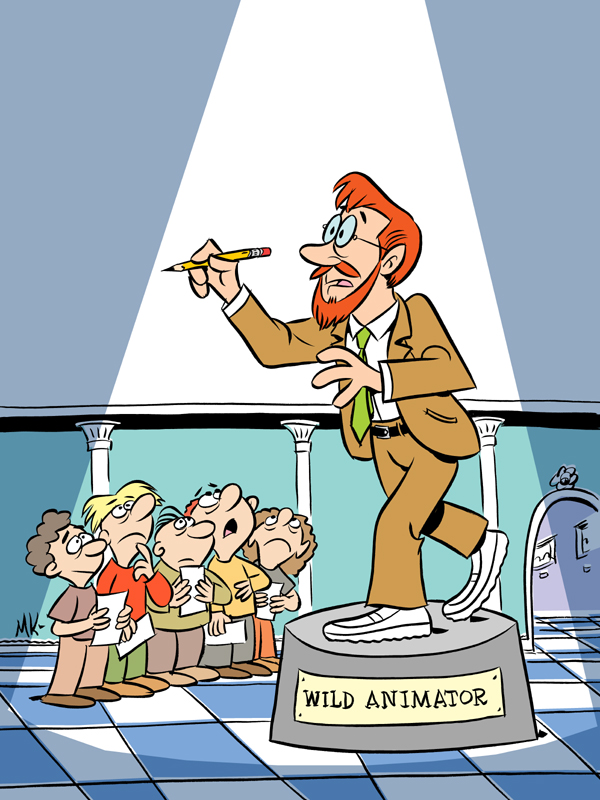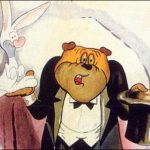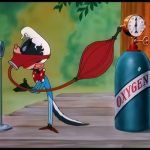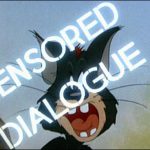
It’s fast becoming history, but once upon a time people made magic out of pencil, paper and paints. It was a time of 35mm film, clattery green moviolas, and giant Oxberry cameras set up on cement floors. Cutting film meant exactly that. It was still true when I broke into the cartoon business, and I loved every second of it. The old guys (as us young kids used to call them) were still working, and they were usually incredulous when you told them how much you enjoyed their work.
Let’s take another look at the commercial application of the animator’s craft…
Yellow Pages
Animated by the very rare and wonderful Steve Muffatti.
Kool-Aid – King Mim
One of Tex Avery’s many Kool-Aid spots. This one was designed by Ed Benedict and animated by Ken Muse. Thurl Ravenscroft reprises his role as the pitcher of Kool-Aid.
Navy – Kid Brother
Another Navy spot made by Playhouse Pictures in1956. Herman Cohen animates. Paul Frees is the College man and his kid brother.
Schlitzerland
Another one from Playhouse Pictures. Animated by Gerard Baldwin and produced in 1956. The short vocals at the opening sound like Herb Vigran and Marvin Miller.
Ford – Lunchtime
Animated by Bill Littlejohn from designs by Chris Jenkyns. Voices by Paul Frees and Dallas McKennon. Also from Playhouse Pictures. 1958.
Heinz Baby Food
Directed and animated by Robert Cannon.
Waffle Whiffer – Diving Bell
Jay Ward had a long run of making commercials for the Quaker Oats Company. Here’s a spot for the Aunt Jemima division directed and animated by Wilson D. “Pete” Burness in 1968. Daws Butler plays the professor while Bill Scott provides the enthusiastic Waffle Whiffer effects. Paul Frees narrates at the end.


 Mike Kazaleh is a cartoonist and animator whose work can be seen in comic books like Bongo’s The Simpsons, Futurama and Papercutz’ Gumby – and on screen in Warner Bros. Tiny Toon Adventures, Ralph Bakshi’s Mighty Mouse: The New Adventures and Cool World.
Mike Kazaleh is a cartoonist and animator whose work can be seen in comic books like Bongo’s The Simpsons, Futurama and Papercutz’ Gumby – and on screen in Warner Bros. Tiny Toon Adventures, Ralph Bakshi’s Mighty Mouse: The New Adventures and Cool World.
























































Steve Muffatti is my ideal.
All of these are better-made than a fair amount of current television animation! (To cite an example of that, it was downright tragic finding that current Tom & Jerry shorts are now cheaply-made in Adobe Flash.)
They don’t even outline the characters anymore, they just blend too easily to the backgrounds and give me headaches.
Better than a lot of television animation in its own time, actually.
In my boomer youth, I could usually tell commercial animation from regular television animation because it was more lavish and often ambitiously designed. HB characters in Kellogg’s cereal ads were more fully animated than the same characters in their own shows. Likewise Bullwinkle when selling Cheerios, and Fred & Barney shilling for Fruity Pebbles.
There were cheapo spots to be sure, but as a rule Yogi Bear moving while talking indicated you’d tuned in during an ad.
@Chris Sobieniak – Honestly, I think it just looks cheap and nasty. Flash cartoons were a different beast when they were simply an enabler for non-animators to get ideas onto the web (in which case you could forgive the medium), but I still can’t believe that anyone considers them ok for broadcast television (where I feel they simply look unprofessional)! As you mention in a reply to another comment below, there used to be a real craft going on – I think it’s a shame that it’s been lost to this sort of thing.
@DBenson – Wow, really? Thanks for that info, as it’s rather eye-opening – I actually didn’t know that, as the videos posted in this article are from quite a way before my own time. They’re also from outside of my culture, too, to a degree*, as I’m from the UK, and to my knowledge we’ve never really had too much in the way of TV ads like these (we have seen a couple of nice-looking animated ones in the last couple of years, though).
*This said, it is familiar from imported culture, and in particular I know that the much later The Ren & Stimpy Show was heavily influenced by animation from this period. The Yellow Pages spot very much put me in mind of that, I will admit! 😉
I often want to blame the current trend in how some execs. would rather buy into an animation based on what they thing the audience would want whether it looks good or not. Flash plays quite a role in that for those who aren’t too creative with their hands or don’t have the time and patience to do it as well as the rest. While true Flash has owned up a world to those who aren’t artistically inclined or had the training needed like the pros, it otherwise became an abused medium simply because it is seen as a crutch, though sometimes good things can be done in flash as long as you aren’t falling back on those weaknesses attributed to it (the recent film Ernest & Celestine is a good example and I didn’t even know it was Flash at all).
I often noticed that as well growing up. The commercials obviously would be well-animated as more money is put into making them the best they can be for their clients. Animation in a TV episode pales in contrast due to the fixed budgets applied.
UK TV in it’s past never had quite the same approach to how commercial TV worked as it did in the US. Sponsorship of a particular program (such as on ITV) did not exist at all until the 1990’s I’ve read (ads were simply slotted into breaks without any real association to the programs they were being promoted on). American TV followed roughly the same path that radio had in programs being made through sponsorship that paid for the show through commercial time. UK TV (and for a number of other European countries) followed a path of TV being a “public service” than a commercial outpost for much of the past half-century before the explosion of private networks and other cable/satellite outlets. If anything, ad agencies and production outfits probably had more time putting together creative ads that spoke on their own and become familiar to the public than for the shows they might be seen against (or even associated with unofficially). Reminded myself of something neat I’d like to share here from a school program ITV aired in the past relating to UK’s history with a chapter on TV and advertising in the 50’s…
https://www.youtube.com/watch?v=9RPJpo65Js0
https://www.youtube.com/watch?v=S44Qn9e51a8
While true advertising was much different for your country, there were quite a good number of animated commercials I have seen done in the past that can be found on YouTube these days. I especially love the stuff done in the 70’s and 80’s myself.
Agreed. The trouble is, I think that’s the minority case! Hopefully that will change with time.
This is very true. Actually, at one point in the late 1990s, the phrase “The adverts are better than the programmes!” became a popular one, funnily enough.
Incidentally, even now, ads are still simply targetted at the audiences watching a given show or channel, rather than actually having anything to do with what’s on at that particular time, or sponsoring/influencing programmes. Though, I do find the “sponsored by” thing to be fascinating – probably due to it being an “exotic” thing.
Oh wow! That evoked some nostalgia! How We Used To Live was something I watched whilst in school, though I never saw this one, as you were only shown what applied to your current history classes. I’ve just finished watching both parts now – this one covered things I’ve heard about from my parents and grandparents.
I’ll have to have a poke around later, methinks!
I suppose, you guys were 50-60 years behind the pack there. Though the ones I’ve spotted on YouTube look nothing like the “sponsor tags” seen in the US for years, often not so much animated as more standard stills/slides of the product or logo with the usual announcement made over it. I don’t see them as much these days, but I noticed the trend continues on Japanese TV with the sponsor lists they often show after the opening title sequences of their programs.
Speaking of sponsorship, I often think of the one incongruity in A Hundred and One Dalmatians where the popular TV show the dogs love to watch is sponsored by a product. I always wondered how many UK fans of that film realized that sort of thing wasn’t common where they were yet we Americans thought that’s what TV would be like anyway.
I see some kids had seen some of these when they were sick at home too. That sort of thing has a similar analog in the US, at least for my generation. We didn’t really had a “Schools & Colleges” type thing, but public TV stations (PBS) use to do what was labeled “Instructional programming” in TV listings. These were basically morning/afternoon blocks of programming that would be shown to schools (or taped for later use). We had our own brand of shows that some of us remember well like “The Letter People”, “Gather ‘Round or “Inside/Out”, though I suppose nothing holds a candle to the classics BBC and ITV use to do themselves.
Steve Muffatti and Bill Littllejohn rock! I wish you could find clips of scenes Bill Littlejohn animated for Peanuts specials!
Was that the Old Groaner singing the Heinz spot?If it wasn’t,it sure sounded like him! Usual great cast of voices!
I really like the Muffatti commercial (which Milton Knight brought to my attention). It makes you think this is going to be a “fashion” ad with great design but no movement, but then you get that burst of robust animation as the guy speaks. Really full work considering he probably only got a week to do it.
Love the baby trying to flee from the directory guy trying to diaper ’em.
Can’t get enough of the Waffle Whiffer!
I wish computers would break and we could go back to traditional animation. It was a true pleasure rolling the paper between your fingers, hands covers in graphite and smelling of pencil shavings and eraser bits. Sigh.
I hear you, Mike. What’s really missing is the whole “getting dirty” part of art that is being sadly missed by the digital transition. There use to be real craft going on when you had to work with physical tools and other gear.